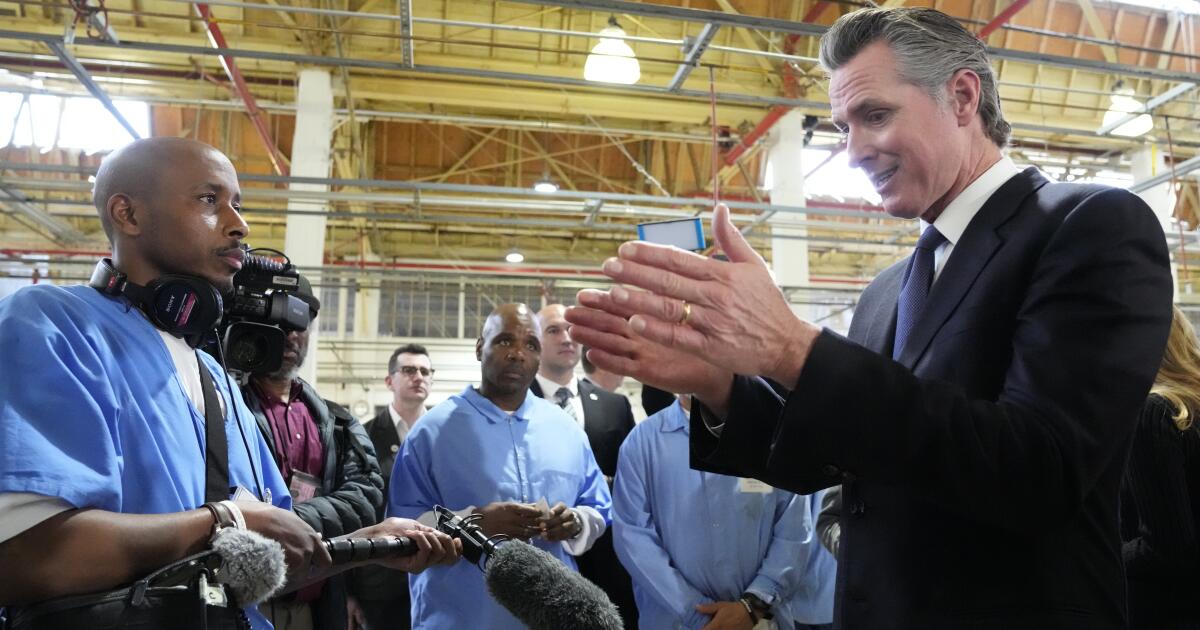Politics
Trump gets a step closer to limiting federal judges, thanks to this California Republican's bill

WASHINGTON — The House of Representatives passed a bill Wednesday brought by one California Republican to limit the ability of federal judges to pass rulings that have national impact — a pet issue that President Trump has seized on as his administration faces a litany of lawsuits since taking office.
“In recent years, it has become glaringly obvious that federal judges are overstepping their constitutional bounds,” Rep. Darrell Issa (R-Bonsall) said on the House floor Wednesday. “A district judge needs to be confined to their district and to people who are in their district.”
The No Rogue Rulings Act would limit federal judges’ ability to issue nationwide injunctions by curtailing their ability to make decisions that affect people outside their district.
Democratic leaders ordered their party to vote against the bill and instead forced a vote to replace it with a resolution condemning a rise in violence against federal judges — including in rhetoric from Trump and his advisor Elon Musk. The resolution failed.
The bill passed with all but one Republican vote. Every Democrat voted against it.
“Since President Trump has returned to office, left-leaning activists have cooperated with ideological judges who they have sought out to take their cases and weaponized nationwide injunctions to stall dozens of lawful executive actions and initiatives,” Issa said in his floor speech.
Trump offered his support for the idea weeks ago, posting on his social media platform Truth Social, “Unlawful Nationwide Injunctions by Radical Left Judges could very well lead to the destruction of our Country!”
Issa blasted federal judges for the myriad injunctions against Trump’s executive actions. When introducing the bill to the House Judiciary Committee, he brought a chart, pointing to the 64 injunctions Trump received in his first term — far above former Presidents Biden (14), Obama (12) or Bush (6).
“The injunctions are nothing more than partisan judicial overreach and have disrupted the president’s ability to carry out his lawful constitutional duty,” Issa said at the committee hearing. “This has allowed activist judges to shape national policy across the entire country … something this Constitution never contemplated.”
But Democrats argue that federal judges are doing their jobs, and that curbing their ability could cause chaos if their rulings are effective only within certain districts and not others.
“If you don’t like the injunctions, don’t do illegal, unconstitutional stuff — it’s that simple,” Rep. Pramila Jayapal (D-Wash.) said Wednesday. “Nationwide injunctions play an essential role in protecting our democracy and holding the political branches accountable.”
Lena Zwarensteyn, advisor to the Leadership Conference on Civil and Human Rights, which joined more than 50 other organizations in sending a letter to Congress opposing the measure, called it “rigging the judiciary in favor of Trump.”
“Congressional efforts that seek to undermine the independence and fairness of the judiciary are blatant attempts to appease a president who thinks he’s king, and they seek to usher in autocracy in ways that should alarm everyone,” Zwarensteyn said in a statement.
Politicians from both parties have grumbled over the years about any one federal judge’s ability to pass rulings that have national impact. Already, nationwide injunctions from district judges often are appealed and, if reversed, wind up in the Supreme Court.
The bill now heads to the Senate.

Politics
Commentary: Even tough-on-crime district attorneys know prison reform is smart

On a recent morning inside San Quentin prison, Los Angeles County Dist. Atty. Nathan Hochman and more than a dozen other prosecutors crowded into a high-ceilinged meeting hall surrounded by killers, rapists and other serious offenders.
Name the crime, one of these guys has probably done it.
“It’s not every day that you’re in a room of 100 people, most of whom have committed murder, extremely violent crimes, and been convicted of it,” Hochman later said.
Many of these men, in their casual blue uniforms, were serving long sentences with little chance of getting out, like Marlon Arturo Melendez, an L.A. native who is now in for murder.
Melendez sat in a “sharing circle,” close enough to Hochman that their knees could touch, no bars between them. They chatted about the decrease in gang violence in the decades since Melendez was first incarcerated more than 20 years ago, and Melendez said he found Hochman “interesting.”
Inside San Quentin, this kind of interaction between inmates and guests isn’t unusual. For decades, the prison by the Bay has been doing incarceration differently, cobbling together a system that focuses on accountability and rehabilitation.
Like the other men in the room, Melendez takes responsibility for the harm he caused, and every day works to be a better man. When he introduces himself, he names his victims — an acknowledgment that what he did can’t be undone but also an acknowledgment that he doesn’t have to remain the same man who pulled the trigger.
Whether or not Melendez or any of these men ever walk free, what was once California’s most notorious lockup is now a place that offers them the chance to change and provides the most elusive of emotions for prisoners — hope.
Creating that culture is a theory and practice of imprisonment that Gov. Gavin Newsom wants to make the standard across the state.
He’s dubbed it the California Model, but as I’ve written about before, it’s common practice in other countries (and even in a few places in the United States). It’s based on a simple truth about incarceration: Most people who go into prison come out again. Public safety demands that they behave differently when they do.
“We are either paying to keep them here or we are paying if they come back out and harm somebody,” said Brooke Jenkins, the district attorney of San Francisco, who has visited San Quentin regularly for years.
Jenkins was the organizer of this unusual day that brought district attorneys from around the state inside of San Quentin to gain a better understanding of how the California Model works, and why even tough-on-crime district attorneys should support transforming our prisons.
As California does an about-face away from a decade of progressive criminal justice advances with new crackdowns such as those promised by the recently passed Proposition 36 (which is expected to increase the state inmate population), it is also continuing to move ahead with the controversial plan to remake prison culture, both for inmates and guards, by centering on rehabilitation over punishment.
Despite a tough economic year that is requiring the state to slash spending, Newsom has kept intact more than $200 million from the prior budget to revamp San Quentin so that its outdated facilities can support more than just locking up folks in cells.
Some of that construction, already happening on the grounds, is expected to be completed next year. It will make San Quentin the most visible example of the California Model. But changes in how inmates and guards interact and what rehabilitation opportunities are available are already underway at prisons across the state.
It is an overdue and profound transformation that has the potential to not only improve public safety and save money in the long run, but to fundamentally reshape what incarceration means across the country.
Jenkins’ push to help more prosecutors understand and value this metamorphosis might be crucial to helping the public support it as well — especially for those D.A.s whose constituents are just fine with a system that locks up men to suffer for their (often atrocious) crimes. Or even those Californians, such as many in San Francisco and Los Angeles, who are just fed up with the perception that California is soft on criminals.
“It’s not about moderate or progressive, but I think all of us that are moderates have to admit that there are reforms that still need to happen,” Jenkins told me as we walked through the prison yard. She took office after the successful recall of her progressive predecessor, Chesa Boudin, and a rightward shift in San Francisco on crime policy.
Still, she is vocal about the need for second chances. For her, prison reform is about more than the California Model, but a broader lens that includes the perspectives of incarcerated people, and their insights on what they need to make rehabilitation work.
“It really grounds you in your obligation to make sure that the culture in the [district attorney’s] office is fair,” she said.
For Hochman, a former federal prosecutor and defense lawyer who resoundingly ousted progressive George Gascón last year, rehabilitation makes sense. He likes to paraphrase a Fyodor Dostoevsky quote, “The degree of civilization in a society is revealed by entering its prisons.”
“In my perfect world, the education system, the family system, the community, would have done all this work on the front end such that these people wouldn’t have been in position to commit crimes in the first place,” he said. But when that fails, it’s up to the criminal justice system to help people fix themselves.
Despite being perceived as a tough-on-crime D.A. (he prefers “fair on crime”) he’s so committed to that goal of rehabilitation that he is determined to push for a new Men’s Central Jail in Los Angeles County — an expensive (billions) and unpopular idea that he says is long overdue but critical to public safety.
“Los Angeles County is absolutely failing because our prisons and jails are woefully inadequate,” he said.
He’s quick to add that rehabilitation isn’t for everyone. Some just aren’t ready for it. Some don’t care. The inmates of San Quentin agree with him. They are often fiercely vocal about who gets transferred to the prison, knowing that its success relies on having incarcerated people who want to change — one rogue inmate at San Quentin could ruin it for all of them.
“It has to be a choice. You have to understand that for yourself,” Oscar Acosta told me. Now 32, he’s a “CDC baby,” as he puts it — referring to the California Department of Corrections and Rehabilitation — and has been behind bars since he was 18. He credits San Quentin with helping him accept responsibility for his crimes and see a path forward.
When the California Model works, as the district attorneys saw, it’s obvious what its value is. Men who once were nothing but dangerous have the option to live different lives, with different values. Even if they remain incarcerated.
“After having been considered the worst of the worst, today I am a new man,” Melendez told me. “I hope (the district attorneys) were able to see real change in those who sat with them and be persuaded that rehabilitation over punishment is more fruitful and that justice seasoned with restoration is better for all.”
Melendez and the other incarcerated men at San Quentin aspire for us to see them as more than their worst actions. And they take heart that even prosecutors like Jenkins and Hochman, who put them behind bars, sometimes with triple-digit sentences, do see that the past does not always determine the future, and that investing in their change is an investment in safer communities.
Politics
DOGE slashes over $5 million by cutting thousands of unused software licenses

The Department of Government Efficiency (DOGE) saved over $5 million a year after discovering several agencies paid for far more software than they were actually using.
For example, the IRS was paying for 3,000 licenses for software but only used 25. Once DOGE discovered the waste, it cut the remaining 99% of the licenses.
“Agencies often have more software licenses than employees, and the licenses are often idle (i.e. paid for, but not installed on any computer),” DOGE wrote in a post on X. “These audits have been continuously run since first posted in February.”
The Department of Labor slashed 68% of unused “project planning” software licenses, DOGE noted, and the Securities and Exchange Commission cut 78% of the remote desktop software programs it was paying for after finding the commission was only using 22% of the programs.
TOP 5 MOST OUTRAGEOUS WAYS THE GOVERNMENT HAS WASTED YOUR TAXES, AS UNCOVERED BY ELON MUSK’S DOGE
According to DOGE, the three changes saved over $5 million a year.
DOGE raised a red flag in February that agencies were paying for more software licenses than employees when it shared a post about the U.S. General Services Administration (GSA).
With 13,000 employees, GSA was paying for 37,000 licenses for WinZip, a program used to archive and compress files.
DOGE’S GREATEST HITS: LOOK BACK AT THE DEPARTMENT’S MOST HIGH-PROFILE CUTS DURING TRUMP’S FIRST 100 DAYS
White House Senior Advisor Elon Musk walks to the White House after landing in Marine One on the South Lawn with President Donald Trump March 9, 2025, in Washington, D.C. (Samuel Corum/Getty Images)
The agency also pays for 19,000 training software subscriptions, 7,500 project management software seats for a division with only 5,500 employees and three different ticketing systems.
The most recent post comes as billionaire Elon Musk steps down as the face of DOGE.
While DOGE was tasked with cutting $2 trillion from the budget, its efforts led to roughly $175 billion in savings due to asset sales, contract cancellations, fraud payment cuts and other ways to eliminate costs, according to an update on DOGE’s website.
MUSK SAYS DOGE SET TO TOP $150B IN FRAUD SAVINGS IN FY 2026

President Donald Trump tasked Elon Musk with heading the Department of Government Efficiency and finding ways to slash $2 trillion from the budget. (Brandon Bell/Getty Images)
The savings translate to about $1,087 in per taxpayer, the website notes.
Musk told reporters in the Oval Office Friday the savings will continue to build, and he is confident total cuts will amount to $1 trillion in the coming years.
“The DOGE influence will only grow stronger,” Musk said. “I liken it to a sort of person of Buddhism. It’s like a way of life, so it is permeating throughout the government. And I’m confident that, over time, we’ll see $1 trillion of savings, and a reduction in $1 trillion of waste, fraud reduction.”
Fox News Digital’s Andrew Mark Miller contributed to this report.
Politics
California contests Trump administration claim that the state obstructs immigration law

SACRAMENTO — Gov. Gavin Newsom’s office sent a letter on Friday requesting that the Trump administration remove California from its list of sanctuary jurisdictions that obstruct the enforcement of federal immigration law.
The Department of Homeland Security issued the list this week in accordance with an executive order President Trump signed in April that directs federal agencies to identify funding to sanctuary cities, counties and states that could be suspended or terminated.
In the letter, Newsom’s office contended that federal court rulings have rejected the argument that California law limiting law enforcement coordination with immigration authorities “unlawfully obstructs the enforcement of federal immigration laws.”
“This list is another gimmick — even the Trump Administration has admitted California law doesn’t block the federal government from doing its job,” Newsom said in a statement. “Most immigrants are hardworking taxpayers and part of American families. When they feel safe reporting crimes, we’re all safer.”
California is among more than a half-dozen states that were included on the list for self-identifying as sanctuaries for immigrants without proper documentation. Forty-eight California counties and dozens of cities, including Los Angeles, Long Beach, San Diego and San Francisco, were also on the Trump administration’s list of more than 500 total jurisdictions nationwide.
The state strengthened its sanctuary policies under a law signed by former Gov. Jerry Brown that took effect in 2018 after Trump won office the first time. Then, state officials tried to strike a balance between preventing local law enforcement resources from being used to round up otherwise law-abiding immigrants without obstructing the ability of the federal government to enforce its laws within the state.
Local police, for example, cannot arrest someone on a deportation order alone or hold someone for extra time to transfer to immigration authorities. But state law does permit local governments to cooperate with U.S. Immigration and Customs Enforcement to transfer people to federal custody if they have been convicted of a felony or certain misdemeanors within a given time frame. The limitations do not apply to state prison officials, who can coordinate with federal authorities.
The law has been a thorn in the side of the Trump administration’s campaign to ramp up deportations, which the president has cast as an effort to rid the country of criminals despite also targeting immigrants with no prior convictions.
In a release announcing the list, DHS Secretary Kristi Noem said politicians in sanctuary communities are “endangering Americans and our law enforcement in order to protect violent criminal illegal aliens.”
“We are exposing these sanctuary politicians who harbor criminal illegal aliens and defy federal law,” Noem said. “President Trump and I will always put the safety of the American people first. Sanctuary politicians are on notice: comply with federal law.”
The Trump administration’s assertion that California’s sanctuary policies protect criminals from deportation appears to irk Newsom, who has repeatedly denied the allegation. Trump’s threat to withhold federal dollars could also pose a challenge for a governor proposing billions in cuts to state programs to offset a state budget deficit for the year ahead.
Homeland Security said jurisdictions will receive a formal notice of non-compliance with federal law and demand that cities, counties and states immediately revise their policies.
-

 Education1 week ago
Education1 week agoVideo: Columbia University President Is Booed at Commencement Ceremony
-

 Technology1 week ago
Technology1 week agoAre Character AI’s chatbots protected speech? One court isn’t sure
-

 News1 week ago
News1 week agoRead the Full ‘Make America Healthy Again’ Report
-

 Culture1 week ago
Culture1 week agoHow Manga Megastar Junji Ito Makes Terrifying Series Like ‘Uzumaki’
-

 Technology1 week ago
Technology1 week agoNow you can watch the Internet Archive preserve documents in real time
-

 Technology1 week ago
Technology1 week agoDiscord might use AI to help you catch up on conversations
-

 News1 week ago
News1 week agoVideo: Trump Repeats False Claims to South African President
-

 Science1 week ago
Science1 week agoTrump Has Cut Science Funding to Its Lowest Level in Decades












